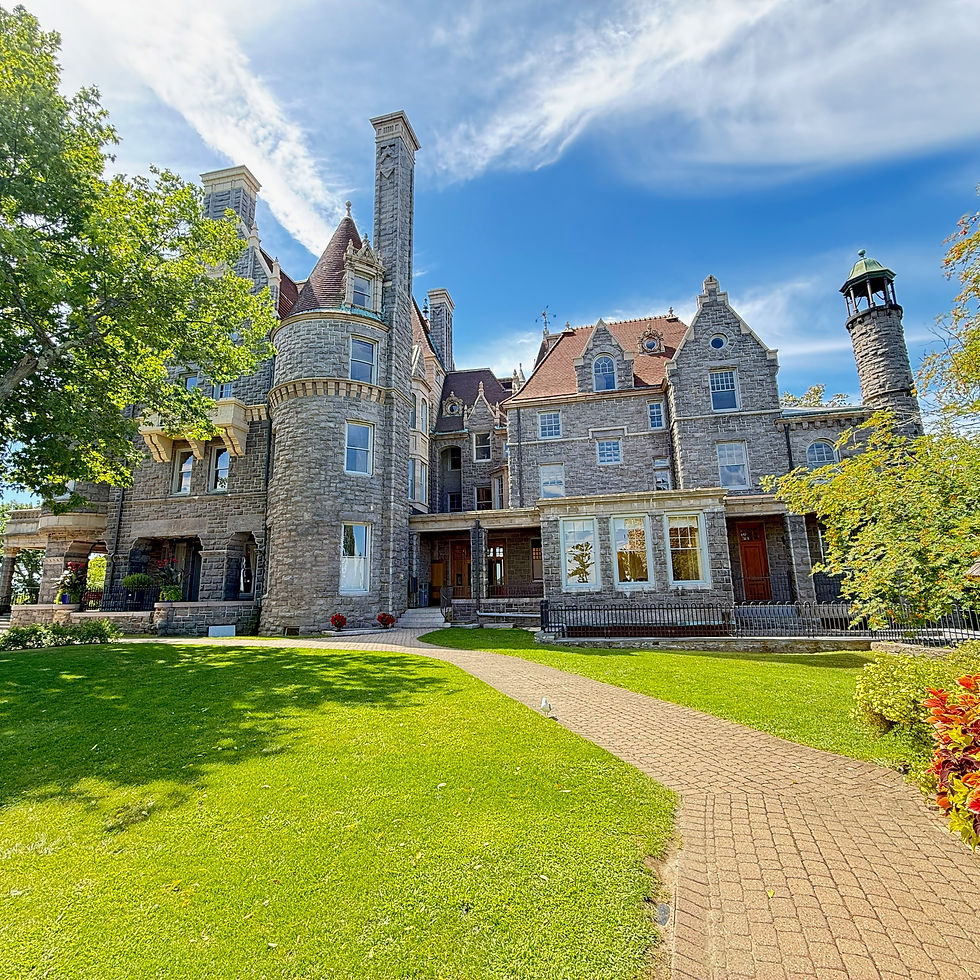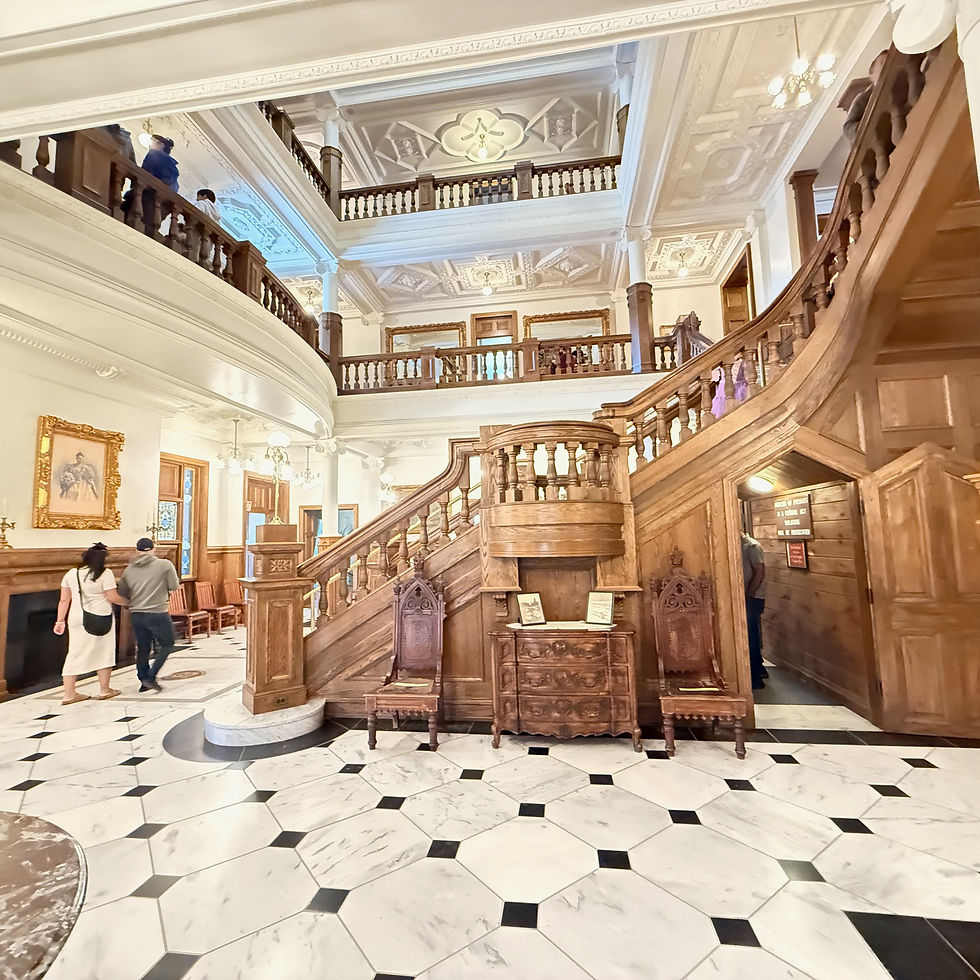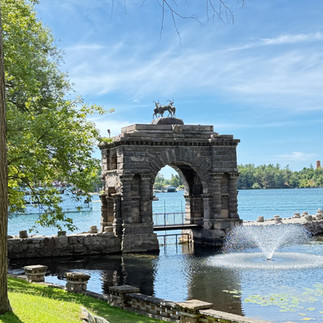A Castle Built on Love: The Fairy Tale of Boldt Castle
- Kim Martinez

- Aug 21
- 7 min read

Manny and I visited Boldt Castle and we were very impressed with the Castle and grounds, but it was the story that was captivating and memorable so this blog will be the telling of the Boldt Castle in a different way then my other blogs.
The Fairy Tale Beginning

Once upon a time, there was a penniless Prussian immigrant boy named George Boldt who arrived in America with his family in 1864 when he was just 13 years old...
Like many fairy tales, this one began with humble origins—George started his American dream by working as a kitchen helper and dishwasher in New York hotels. But this young man had ambition burning

in his heart and an eye for hospitality that would change his destiny. He worked his way up through the hotel industry, learning every aspect of the business from the ground up.
Falling in Love

Along the way, he met and fell deeply in love with Louise Kehrer, a beautiful and cultured woman from Philadelphia whose father was a German-born tavern keeper who became steward of the exclusive Philadelphia Club. Louise knew the hotel business well and became George's constant companion and business partner. In 1881, with Louise's encouragement and business acumen, they purchased the small Bellevue Hotel in Philadelphia. Together, they transformed it with such amazing attention to detail and overall quality that their reputation for excellence spread far and wide.

Act of Kindness Repaid
Legend tells us that George and Louise's big break came through a simple act of kindness—the kind that only happens in fairy tales. While staying at a resort, they encountered Astor family relatives in need of accommodation. Without hesitation, George and Louise gave up their own rooms to help these strangers.

Whether the details have grown more magical over the years matters little; what's certain is that their generosity caught the attention of William Waldorf Astor, who was so impressed by their selfless hospitality that he offered George the chance of a lifetime.
Grand Waldorf Hotel
When Astor decided to build his grand Waldorf Hotel in New York City in 1890, he invited George to oversee every aspect of his new endeavor—from construction to management. George became the proprietor of the prestigious Waldorf-Astoria, while Louise remained his partner in creating the ultimate in luxury hospitality. This act of kindness became known as the origin of the "Waldorf Principle"—the hotel's legendary service built on such selfless acts.
George's innovative approach to hospitality revolutionized the industry. He is credited with inventing room service, transforming how guests experienced luxury accommodations. His attention to every detail, from the finest linens to personalized service, set new standards that hotels worldwide would strive to match.
By the turn of the century, George had transformed from that penniless immigrant boy into one of America's most successful hoteliers, and he was ready to build the ultimate monument to his love for Louise—a castle fit for his queen.
The Castle: A Monument to Love
George C. Boldt, now the proprietor of the Waldorf-Astoria in New York City and owner of the Bellevue-Stratford Hotel in Philadelphia, began construction of his dream castle in 1900 on Heart Island in the Thousand Islands region of the St. Lawrence River. This wasn't just any summer home—it was to be a 120-room Rhineland castle, complete with tunnels, a powerhouse, Italian gardens, a drawbridge, and a dove cote.
Alster Tower Boldt Castle Power house
"playhouse for the children"
The castle was designed in the Rhineland style, featuring:
- Size: 120 rooms spanning six stories
- Architecture: Medieval European castle design with towers, turrets, and elaborate stonework
- Materials: Imported materials from around the world, including marble and fine hardwoods
- Construction Timeline: Started in 1900, expected completion around 1904
- Cost: An estimated $2.5 million (equivalent to about $75 million today)
Boldt spared no expense, purchasing his own granite quarry to ensure the stone was cut to perfection. Every detail was meticulously planned, from the imported Italian marble to the custom-designed furniture already ordered and stored, waiting to fill the magnificent rooms.
The Island: Reshaping Love
Heart Island sits in the St. Lawrence River between New York and Ontario, originally covering about 5.5 acres. But the natural island shape wasn't romantic enough for Boldt's grand gesture. He had the island literally reshaped and expanded to 6.5 acres, sculpting it into a perfect heart shape as a symbol of his devotion to his beloved wife, Louise.
The island's location in the Thousand Islands region made it accessible by boat from the mainland, and Boldt ensured there were proper docking facilities for the elaborate yachts that would bring guests to his castle paradise.
Other Island Structures
Boldt's vision extended far beyond just the castle. The island featured several other impressive buildings:
- The Powerhouse: A miniature castle in its own right, housing the electrical generators and mechanical systems
- The Dove Cote: An ornate tower designed to house doves
- Italian Gardens: Elaborate landscaped gardens with marble statuary
- Tunnels: Underground passages connecting various buildings
- Boat Houses: Multiple structures to house the family's collection of yachts and boats
Progress: A Dream Taking Shape

By 1904, the project was progressing beautifully. The castle's stone walls were rising majestically from the heart-shaped island, and the elaborate details were being carved by skilled craftsmen. The imported materials were arriving regularly—Italian marble for the grand staircase, rare hardwoods for the paneling, and custom-designed furniture pieces created by the finest artisans.
Boldt had even purchased his own granite quarry to ensure every stone was cut to his exacting standards. The powerhouse was nearly complete, the gardens were taking shape, and the castle itself was approaching the point where interior finishing could begin. Everything was moving according to plan for what would have been one of America's most spectacular private residences.
The End of the Fairy Tale

In January 1904, tragedy struck. Louise Boldt died suddenly of tuberculosis at the Waldorf-Astoria in New York City. Heartbroken and unable to continue building what was meant to be a monument to their love, George Boldt immediately telegraphed the island with a simple message: "Stop all construction."
The workers laid down their tools and left. The castle, so close to completion, was abandoned. Boldt never returned to Heart Island, unable to bear the memories of what might have been.
The Dark Years: Abandonment and Decay
For the next 73 years, from 1904 to 1977, Boldt Castle stood as a haunting reminder of love lost. The unfinished castle and its outbuildings were left completely unprotected against the harsh Thousand Islands weather and, unfortunately, vandals.
During these decades:
- Windows were broken and left open to the elements
- Rain and snow poured through the roof
- Vandals covered walls with graffiti
- Copper and other valuable materials were stripped away
- The elaborate gardens became overgrown
- The castle became known as a romantic ruin
The 1960s and 1970s were particularly damaging, as the site became a popular destination for vandals who left their mark throughout the building. Some of this graffiti remains today on the upper floors as a stark reminder of this dark period.
Full Circle: Restoration and Renewal
In 1977, the Thousand Islands Bridge Authority purchased Boldt Castle and began an ambitious restoration project. Using Boldt's original architectural plans and, where possible, original materials that had been stored for over 70 years, they began the painstaking process of bringing the castle back to life.
The restoration efforts have been remarkable:
- Structural Repairs: Roofs were rebuilt, windows replaced, and the stone structure stabilized
- Interior Restoration: Several floors have been completely restored using original plans and materials
- Original Materials: Some of the furniture and fixtures that Boldt had ordered and stored were discovered and incorporated into the restoration
- Authentic Details: Craftsmen used traditional techniques to recreate the elaborate woodwork and stonework










Today, visitors can explore the restored lower floors, which showcase the grandeur Boldt originally envisioned. The expense of renovating and furnishing each floor is immense and time consuming and all the proceeds from the tours of the Castle go back into the renovation. There is still a lot to do and the upper floors remain unfinished, complete with 1970s graffiti, providing a powerful "then and now" perspective that tells the complete story of the castle's journey from dream to ruin to restoration.
The Yacht House: A Castle in Miniature

Located on nearby Wellesley Island (accessible by car), the Yacht House served as both a functional boat storage facility and a stunning architectural statement. Built in the same Rhineland castle style as the main castle, this impressive structure housed Boldt's collection of luxury yachts and boats.

History and Function:
- Designed to complement the main castle's architecture
- Served as storage for multiple luxury vessels
- Featured elaborate stonework and castle-like details
- Now serves as a visitor center and museum
- Provides easy access for visitors arriving by car before taking the short ferry to Heart Island

The Yacht House demonstrates that even Boldt's utilitarian buildings were designed with the same attention to detail and grandeur as his main castle. A testament to his vision that every aspect of his island paradise should reflect his love for Louise.
The Love Story that continues to captivate
This tragic love story continues to captivate visitors who come to see both the realized dream in the restored sections and the haunting reminder of loss in the unfinished upper floors.
Boldt Castle stands as one of the most poignant monuments to love ever built A fairy tale that didn't quite get its happy ending, but found new life through restoration and the thousands of visitors who come to experience its unique blend of grandeur and heartbreak.












































Comments